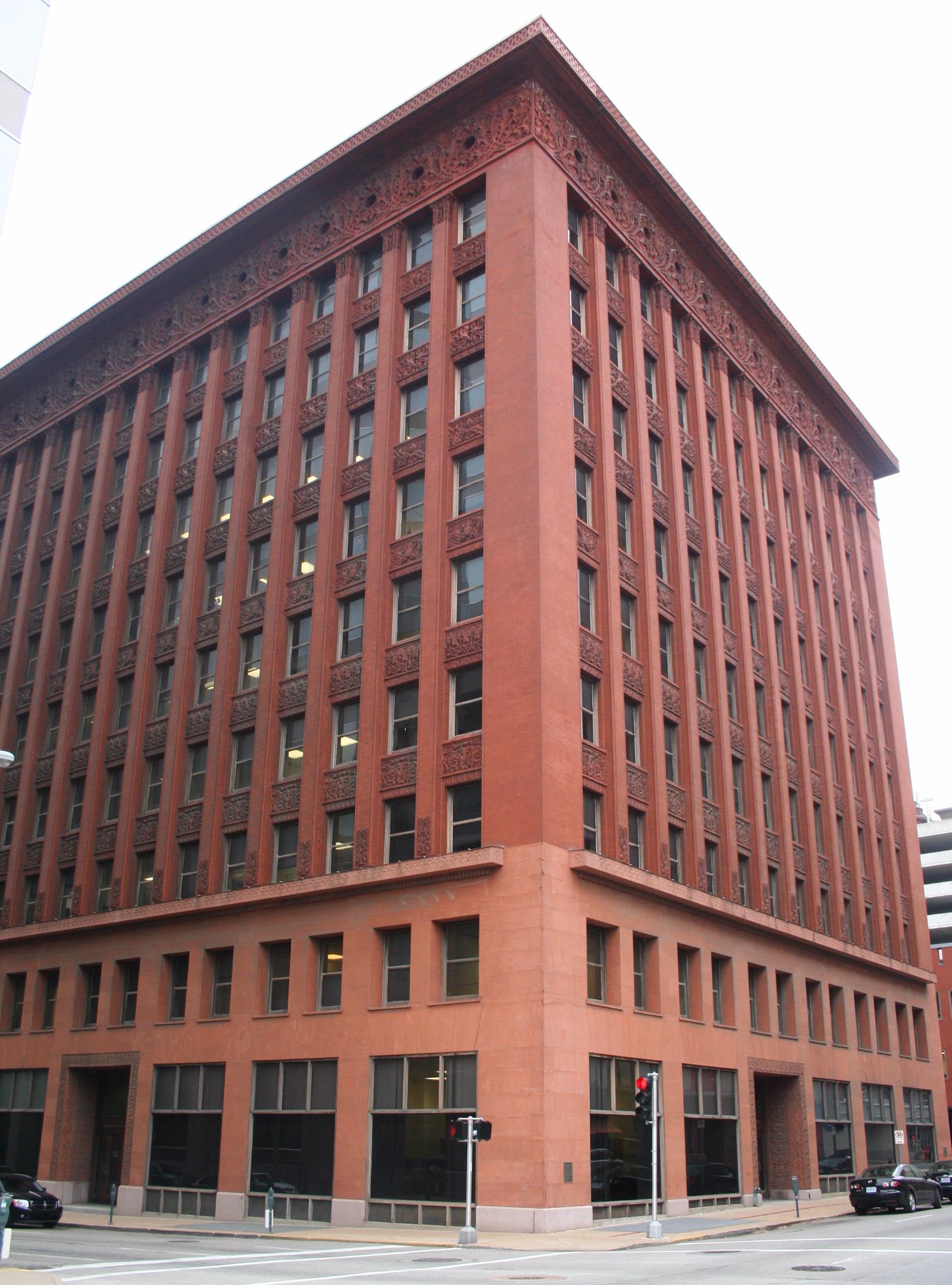Sullivan’s style and theoretical stance reflect his exposure to particular influences over the course of his training and early work experience. His desire for a thoughtful architecture, not one based simply imitating the orders of the past, is evident in his aversion to the Beaux Arts disposition of MIT ("Louis Henry Sullivan"). Leaving MIT, his subsequent work with Frank Furness (1839-1912) likely exposed him for the first time to the architectural thought of Ruskin and Viollet-le-Duc as well as to the Gothic styles that they loved and whose influence is evident in Furness’ work as well. It is not surprising, then, that Sullivan would come away with a love of ornament, especially as informed by nature.
Image: An Example of Ornament by Frank Furness [http://uchs.net/HistoricDistricts/images/furness_lib2.jpg]
After a stint under William Le Baron Jenney (1832-1907), the architect and engineer behind the first steel-framed office building in Chicago, Sullivan interestingly decided to leave the U.S. to study at the Ecole des Beaux Arts in Paris. Perhaps this was a reaction to his encounter with a new world of construction possibilities under Jenney, a need to find a way to synthesize some kind of theoretical underpinning that would tie together his experiences so far. If this was the case, he did not find his answers at the Ecole—he spent only a year there before returning to Chicago.
Bergdoll conjectures that Sullivan found his true inspiration while in Europe as a result of encountering the works of Victor-Marie Ruprich Robert (1820-1887), a lecturer at the Ecole des Arts Decoratifs who had developed a “system of deriving ornament from an analytical study of plants” (2007, p. 19), which Sullivan used in his own drawings. Ruprich Robert’s approach was new in that it treated ornament not as an exercise in historicism, but as a logical outworking of geometry from a study of nature. His writings prefigure those of Sullivan: “’Nature is inexhaustible’, ‘in all the examples I have chosen, I ever did search the intentions of nature, as to the geometrical dispositions, and to the character of outlines’” (p. 20). He also observes a rationalism in nature—“No two leaves on a tree are identical, ‘and however the same law has formed them. It is this law, this principle that I will point out’” (p. 20).
Images: Sullivan’s tracings of Ruprich Robert plates (Bergdoll, 2007, p. 21) [Omitted due to restrictions on online reproduction of copyrighted content. See the images on p. 21 of the article, available on JSTOR at the following link: http://www.jstor.org/stable/40033846]
Sullivan’s return to Chicago after his time in Paris is characterized both by work “towards developing an ornamental vocabulary that could harmonize with, and even give expression to, the rapid advances in the engineering construction in new kinds of … metallic frames” (p. 22) and by an extension of Ruprich Robert’s methodology to the study of human and animal forms and musculatures. With this background he would later write his famous lines on “form follows function”, praising the examples he had observed and establishing this natural outworking as law.
Whether it be the sweeping eagle in his flight or the open apple-blossom, the toiling work horse, the blithe swan, the branching oak, the winding stream at its base, the drifting clouds—over all the coursing sun, form ever follows function, and this is the law. (Sullivan 1896)
Looking at his architectural works, it is easy to see how his ideas manifested themselves in built form. Bergdoll references the Wainwright Building in St. Louis (1891) and the Guaranty Building in Buffalo, NY (1894), but his later Carson Pirie Scott Building in Chicago (1899) is also a good example. The Guaranty building the one that would perhaps be deemed the most organic or ornamented, with every surface intricately carved and a flowering cornice flowing out of the stems that establish the vertical thrust of the building. But even in this organic ornament, his moves are constrained and hint at a structure behind that is far from organic or ornament, though Sullivan probably would have argued it was still the natural outworking of the material and logic of the building. And it does seem to fit.
Image: The Guaranty Building, Buffalo, NY [https://blogger.googleusercontent.com/img/b/R29vZ2xl/AVvXsEgQxxDNXMHpdtTOBkB7gLBeOTvqYc3Ww3eyWv8bsYtqIyS9zpw1atil42Pca747VOB9hF5bD6GMC4wB3qGIKy_dPmhjl_ojasVPeZM9dBsCJpaVVZmJVD23RmhdzGQMFYNg2XHIEsK0tB93/s1600/Buffalo+%2528515%2529.JPG]
The Wainwright Building and the Carson Pirie Scott building provide two inverse explorations of structure and ornament. Whereas the Wainwright building projects from the ground in solid, unadorned columns, allowing the ornament between levels to take a background role and the most ornate embellishments to cap the building at the attic level, the Pirie Scott building is lavish at the ground level with its ornate ironwork, leaving the upper levels to express stark verticality in true Chicago style and modern simplicity.
Images: The Wainwright Building, St. Louis (left) and the Carson Pirie Scott Building, Chicago [http://stlouis-mo.gov/government/departments/planning/cultural-resources/images/Wainwright_124825_2.JPG], [http://georgietourgie.webs.com/carsonp1.jpg]
Whether highly ornamental or more reserved, Sullivan’s works reveal a man not afraid to try new permutations in built form who could at the same time remain rigorous in his quest for an architecture of the new age that had integrity. Bergdoll notes that “Sullivan's whole career might be summarized as the gradual realization of that programme, a project oriented towards an ever greater coordination of structure and ornament” (2007, p. 22). His honest struggle with these themes left subsequent generations a wealth of ideas to ponder and take forward to the next frontier.
Works Cited
Bergdoll, B. (2007). Of Crystals, Cells, and Strata: Natural History and Debates on the Form of a New Architecture in the Nineteenth Century. Architectural History, 50, 1-29. doi: 10.2307/40033846
Louis Henry Sullivan : architect biography. (n.d.). Retrieved from http://architect.architecture.sk/louis-henry-sullivan-architect/louis-henry-sullivan-architect.php
Sullivan, L. H. (1896). The tall office building artistically considered. Inland architect & news record, 27, 32-34.




No comments:
Post a Comment